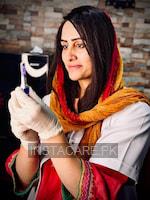Molluscum Contagiosum - Symptoms, Risk factors and Treatment
Last Updated On Saturday, April 20, 2024
Molluscum Contagiosum in Urdu
Molluscum contagiosum جلد کا ایک انفیکشن ہے جو انسان سے دوسرے شخص میں پھیلتا ہے۔ عام طور پر، یہ خود ہی حل ہوجاتا ہے اور اسے کسی علاج کی ضرورت نہیں ہوتی ہے۔ مناسب احتیاطی تدابیر جیسے کہ اپنے تولیوں، استرا کا استعمال کرنا اور انہیں دوسروں کے ساتھ نہ بانٹنا، اور اچھی ذاتی حفظان صحت کو برقرار رکھنا انفیکشن سے بچ سکتا ہے۔
Molluscum Contagiosum in English
Molluscum contagiosum is a skin infection that typically results in characteristic bumps on the skin which may be present separately or in groups.
What causes Molluscum contagiosum?
Molluscum contagiosum is caused by molluscum contagiosum virus (MCV) - a type of pox-virus.
How does this disease spread?
Molluscum contagiosum is spread by direct person-to-person physical contact.
Direct physical contact:
Being in close company with the infected person can spread the infection as it is contagious. Direct skin-to-skin contact can transfer the infection from one person to another.
Sharing articles with an infected person:
Sharing articles with an infected person can result in the spread of the infection as the virus can survive on fomites. Sharing of personal objects like razors, towels, gloves, beddings, clothes, etc can spread the infection from one person to another.
Sexual contact:
Molluscum contagiosum can spread through sexual contact. The lesions are mostly on the genitals and inner side of the thigh if the infection is sexually transmitted.
Autoinoculation:
The virus can spread from one part of the body, of the same person, to another part, by touching different areas of the body after touching or scratching the lesion. This is known as autoinoculation.
Risk factors for getting Molluscum contagiosum:
The risk factors that predispose a person to get molluscum contagiosum are:
Young age:
Children are mostly affected by molluscum contagiosum especially in between ages 1 to 10 years.
Developing countries:
Poor sanitation and crowding can result in the spread of infection from one person to another.
Hot and humid conditions:
People who live in crowded, hot, and humid conditions are more likely to get molluscum contagiosum.
Lowered immunity:
Any condition that causes the immune system to be suppressed causes different bacteria to infect an individual as the immune system is responsible for fighting off different infections. Conditions like AIDS, cancer chemotherapy, diabetes, etc. can predispose a person to catch infections like molluscum contagiosum. Low immunity can also cause the infection to become complicated and resistant to treatment.
Eczema:
Preexisting skin conditions like eczema, especially atopic dermatitis- one of its type, can predispose a person to get molluscum contagiosum infection.
Symptoms of Molluscum contagiosum:
Molluscum contagiosum typically results in benign bumps (papules) known as Mollusca that are painless. They have a characteristic appearance that helps in the diagnosis. They appear waxy, shiny with an indentation in the middle. They are filled with pus, which gives them a pearl-like appearance. They are mostly benign, but sometimes they may be red and swollen and accompanied by itching.
The lesions may appear anywhere on the body, but the face is most commonly affected. If sexually transmitted, the lesions are mostly present in the inner aspects of the thighs and genitalia. The bumps are not present on the palm and soles.
Diagnosis:
The diagnosis is mostly made by looking at the lesion. The doctor identifies the lesion due to its characteristic appearance. However, in some cases, a skin biopsy may be ordered to rule out other similar diseases like skin cancers or other infections that need attention.
Complications of Molluscum contagiosum:
Generally, the infection is benign, and complications are rare. However, the following complications may arise:
Scarring:
Mostly, the infection resolves completely and leaves behind no scars, but scratching the lesion can result in permanent scarring. Some treatment strategies for molluscum contagiosum can also cause scarring.
Conjunctivitis:
If the lesion is on the eye, it can cause conjunctivitis- inflammation of a membrane (conjunctiva) of the eye.
Superinfection:
The Mollusca (bumps) can be infected by another infection, mostly bacteria, complicating the infection further. It may be represented with pain and requires antibiotics to treat.
Treatment of Molluscum contagiosum:
Usually, the infection is self-limiting and should resolve by itself in around 6 to 12 months. But in some cases, it may require treatment. The following treatment strategies may be used:
Antiretroviral therapy: It is mostly used in immunocompromised patients to fight off the virus.
Topical ointments: Doctors may prescribe topical ointments to apply directly on the bumps. Several drugs may be used topically such as Potassium hydroxide, Podophyllotoxin, etc.
Other than these, the following treatment strategies may be used but these may be painful and can cause permanent scarring:
Cryotherapy: This involves freezing the lesion with liquid nitrogen.
Curettage: This involves scraping the lesion.
Laser: This involves using a beam of light to destroy the lesion.
Diathermy: This involves using heat to destroy the lesions.
When the bumps are gone, that means the infection has cleared up, and it will not spread to others.
Prevention of molluscum contagiosum:
Infection with the molluscum contagiosum virus does not provide lifelong immunity and can occur again. The following measures can prevent catching the infection:
- Avoiding close contact with infected people
- Avoiding crowded places
- Avoiding sharing of personal articles
- Maintaining good personal hygiene
- Proper handwashing
If you are infected, it is advisable to tell others and avoid close contact to prevent spreading the virus. Moreover, it is advisable to:
- Avoid sexual contact
- Covering bumps with a bandage
- Avoid touching the lesions
Conclusion:
Molluscum contagiosum is a skin infection that spreads from person to person. Usually, it resolves on its own and does not require any treatment. Appropriate preventive measures such as using your towels, razors and not sharing them with others, and maintaining good personal hygiene can prevent getting the infection.







